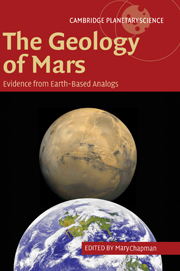Book contents
- Frontmatter
- Contents
- Preface: the rationale for planetary analog studies
- List of contributors
- 1 The geology of Mars: new insights and outstanding questions
- 2 Impact structures on Earth and Mars
- 3 Terrestrial analogs to the calderas of the Tharsis volcanoes on Mars
- 4 Volcanic features of New Mexico analogous to volcanic features on Mars
- 5 Comparison of flood lavas on Earth and Mars
- 6 Rootless volcanic cones in Iceland and on Mars
- 7 Mars interior layered deposits and terrestrial sub-ice volcanoes compared: observations and interpretations of similar geomorphic characteristics
- 8 Lava—sediment interactions on Mars: evidence and consequences
- 9 Eolian dunes and deposits in the western United States as analogs to wind-related features on Mars
- 10 Debris flows in Greenland and on Mars
- 11 Siberian rivers and Martian outflow channels: an analogy
- 12 Formation of valleys and cataclysmic flood channels on Earth and Mars
- 13 Playa environments on Earth: possible analogs for Mars
- 14 Signatures of habitats and life in Earth's high-altitude lakes: clues to Noachian aqueous environments on Mars
- 15 The Canyonlands model for planetary grabens: revised physical basis and implications
- 16 Geochemical analogs and Martian meteorites
- 17 Integrated analog mission design for planetary exploration with humans and robots
- Index
- Plate section
- References
3 - Terrestrial analogs to the calderas of the Tharsis volcanoes on Mars
Published online by Cambridge University Press: 18 September 2009
- Frontmatter
- Contents
- Preface: the rationale for planetary analog studies
- List of contributors
- 1 The geology of Mars: new insights and outstanding questions
- 2 Impact structures on Earth and Mars
- 3 Terrestrial analogs to the calderas of the Tharsis volcanoes on Mars
- 4 Volcanic features of New Mexico analogous to volcanic features on Mars
- 5 Comparison of flood lavas on Earth and Mars
- 6 Rootless volcanic cones in Iceland and on Mars
- 7 Mars interior layered deposits and terrestrial sub-ice volcanoes compared: observations and interpretations of similar geomorphic characteristics
- 8 Lava—sediment interactions on Mars: evidence and consequences
- 9 Eolian dunes and deposits in the western United States as analogs to wind-related features on Mars
- 10 Debris flows in Greenland and on Mars
- 11 Siberian rivers and Martian outflow channels: an analogy
- 12 Formation of valleys and cataclysmic flood channels on Earth and Mars
- 13 Playa environments on Earth: possible analogs for Mars
- 14 Signatures of habitats and life in Earth's high-altitude lakes: clues to Noachian aqueous environments on Mars
- 15 The Canyonlands model for planetary grabens: revised physical basis and implications
- 16 Geochemical analogs and Martian meteorites
- 17 Integrated analog mission design for planetary exploration with humans and robots
- Index
- Plate section
- References
Summary
Introduction
The structure and morphology of Martian calderas have been well studied through analysis of the Viking Orbiter images (e.g., Mouginis-Mark, 1981; Wood, 1984; Mouginis-Mark and Robinson, 1992; Crumpler et al., 1996), and provide important information on the evolution and eruptive styles of the parent volcanoes. Using Viking data it has been possible, for numerous calderas, to define the sequence of collapse events, identify locations of intra-caldera activity, and recognize post-eruption deformation for several calderas. Inferences about the geometry and depth of the magma chamber and intrusions beneath the summit of the volcano can also be made from image data (Zuber and Mouginis-Mark, 1992; Scott and Wilson, 1999). In at least one case, Olympus Mons, analysis of compressional and extensional features indicates that, when active, the magma chamber was located within the edifice (i.e., at an elevation above the surrounding terrain). The summit areas of Olympus and Ascraeus Montes provide evidence of a dynamic history, with deep calderas showing signs of having been full at one time to the point that lava flows spilled over the caldera rim (Mouginis-Mark, 1981). Similarly, shallow calderas contain evidence that they were once deeper (e.g., the western caldera of Alba Patera; Crumpler et al., 1996). Some of the best evidence for circumferential vents on Mars can be found on Pavonis Mons, where several sinuous rilles can be identified that must have originated from vents close to the rim (Zimbelman and Edgett, 1992).
- Type
- Chapter
- Information
- The Geology of MarsEvidence from Earth-Based Analogs, pp. 71 - 94Publisher: Cambridge University PressPrint publication year: 2007
References
- 3
- Cited by

